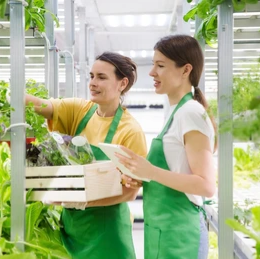
About iGrowing
At iGrowing, we believe controlled environment agriculture (CEA) plays an increasingly vital role in how we grow, access and sustain our access to healthy food. By integrating advanced growing technologies with practical, commercial design, we aim to improve access to nutritious, chemical-free produce, enhance product quality and increase productivity whilst supporting biodiversity and ecological resilience.
In a world of increasingly unpredictable weather patterns, rising populations and a continual loss of fertile, productive land, our work responds to a simple but urgent challenge: growers and businesses are being asked to produce more, improve quality and reduce environmental impact — all within an unstable and resource-constrained climate. We believe that innovation, when grounded in commercial reality, can deliver systems that serve people, profit and planet simultaneously.
Our Story
iGrowing began as an innovation project from the team at Plant Raisers, the UK’s largest propagator of tomatoes and cucumbers. That collaboration shaped our understanding of scalable, high-performance growing systems and the importance of developing technology that delivers real value to live market supply chains. From those roots, we’ve grown into a company that designs and delivers complete CEA solutions — spanning food, feed and forestry.
Now based in Ingleton, our dedicated research and development centre continues to build on the same guiding principles that defined our early work: balancing crop quality, energy efficiency and commercial return. Every system we design is trialled, refined and operated in real-world conditions — ensuring that what we deliver isn’t just innovative in theory, but reliable, practical and proven in practice.
Our Purpose
Our purpose is to create sustainable, future-proofed growing systems that add value to households, businesses, growers and communities. From nutrient-dense food and high-welfare livestock feed to resilient tree propagation, our work supports a regenerative, circular approach to production — one that strengthens food security, reduces reliance on imports and supports healthier ecosystems.
We’re driven by the belief that controlled environment systems can do more than grow crops. They can improve local resilience, reduce waste, create skilled jobs and regenerate the connection between people and how their food is produced.
Our Vision
We envision a future where controlled environment agriculture is an integral part of how the world grows — working alongside traditional farming to enhance productivity, crop quality and environmental balance. A world where growers can produce reliably, businesses operate responsibly, and communities enjoy access to healthy, local food all year round.
Our long-term vision is to help create a food system where productivity, ecological care and commercial viability work in harmony — ensuring that what nourishes us also sustains the planet.
Our Commitments
Design affordable, energy-efficient systems that make controlled environment growing accessible across a range of commercial and domestic applications.
Prove commercial viability through real-world operation, not just theory — ensuring every system we build adds measurable value to those who rely on it.
Partner with leaders in agriculture, research and innovation to continually evolve our technology into tangible, scalable solutions.
Build a future where productivity, sustainability and ecological health are not competing goals, but shared outcomes.
Why Vertical Farming
As pressure on global food systems intensifies, traditional farming alone can no longer meet demand. Fertile land is diminishing, weather patterns are becoming increasingly unpredictable, and the environmental cost of long-distance food transport continues to rise. Vertical farming offers a smarter, more sustainable way forward — one that complements conventional agriculture by growing more with less.
By moving production indoors, crops are no longer bound by season, soil, or climate. CEA allows precise regulation of light, temperature, humidity and nutrients — creating the ideal growing conditions 365 days a year. The result is consistent, high-quality production that’s independent of external volatility.
This precision doesn’t just improve yield — it improves nutrition. Leafy greens and microcrops grown in controlled environments retain up to 50% more nutrients than those transported through traditional supply chains and are completely free from the pesticide residues found on nearly half of supermarket produce. Hydroponic systems deliver nutrients directly to the roots, maximising efficiency while using up to 90% less water than field-grown crops.
Vertical farming also strengthens local resilience. By growing closer to the point of use — whether that’s a kitchen, a workplace, a greenhouse or a forestry hub — we increase output cut transport miles, reduce waste and create skilled local jobs. It’s a decentralised approach that brings food, feed and plant production back into communities, where it belongs.
For iGrowing, vertical farming isn’t just about tech and innovation — it’s about redefining how we can secure access to nutritious food, increase resilience within our agricultural sectors and improve and repair habitats and biodiversity in a way that remains in a positive balance with both people and the planet.



